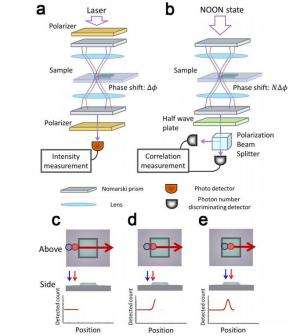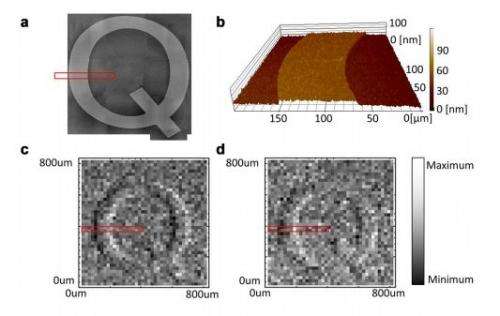February 11, 2014 report
Researchers use quantum entanglement to improve differential interference contrast microscopy

(Phys.org)—A team of researchers with members from Hokkaido and Osaka Universities in Japan has used quantum entanglement of photons to improve image results created using differential interference contrast microscopy. In their paper published in Nature Communications, the team describes how they used entangled photons to enhance an image taken of an etched (to a depth of just 17 nanometers) letter "Q" on a glass plate, and how much improvement was observed.
Scientists have been using a type of microscope that relies on reading information from pairs of photons reflected off of a surface for several years. The difference between the information provided by each of the photons (the difference in phase) allows for creating an image. The result is stunningly sharp ultra-close-up images of three dimensional surfaces (such as microchips or microorganisms). Until now, however, the resolution of this type of microscopy—known as differential interference contrast microscopy—has been limited by the standard quantum limit—which is based on the Heisenberg uncertainty principle. Scientists have also known for some time that if entangled photons were used instead, they could bypass that limit and create images with better resolution. In this new effort, that's exactly what the researchers have done.
The reason that using entangled photons allow for more information is because measuring one gives information about the other, which results in more information obtained than from two un-entangled photons. The researchers tested this theory by replacing the part of the microscope that emits photons, with one that emitted entangled photons—with it in place they etched the letter "Q" into a glass plate and then proceeded to create an image of it using their new and improved microscope. In so doing, they found an improved signal to noise ratio of 1.35—which can be seen by the naked eye when comparing photographs of the same etching done by both the new and old method.

Besides offering a way to create sharper images, the new technique might also prove useful for looking at material that is easily damaged by strong light—it might also lend itself to other types of measuring devices such as interferometers.
More information: An entanglement-enhanced microscope, Nature Communications 4, Article number: 2426 DOI: 10.1038/ncomms3426 . On Arxiv: arxiv.org/abs/1401.8075
Abstract
Among the applications of optical phase measurement, the differential interference contrast microscope is widely used for the evaluation of opaque materials or biological tissues. However, the signal-to-noise ratio for a given light intensity is limited by the standard quantum limit, which is critical for measurements where the probe light intensity is limited to avoid damaging the sample. The standard quantum limit can only be beaten by using N quantum correlated particles, with an improvement factor of √N. Here we report the demonstration of an entanglement-enhanced microscope, which is a confocal-type differential interference contrast microscope where an entangled photon pair (N=2) source is used for illumination. An image of a Q shape carved in relief on the glass surface is obtained with better visibility than with a classical light source. The signal-to-noise ratio is 1.35±0.12 times better than that limited by the standard quantum limit.
Journal information: Nature Communications
© 2014 Phys.org



















